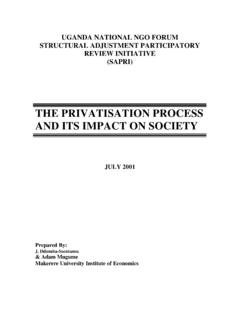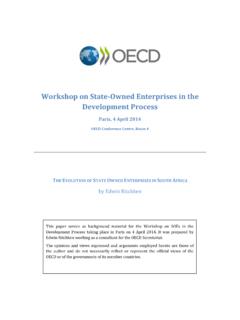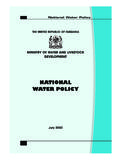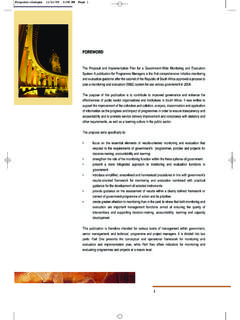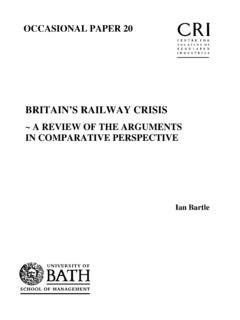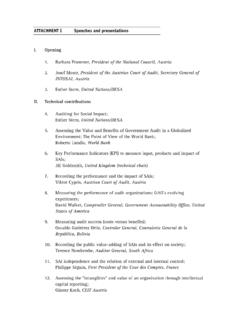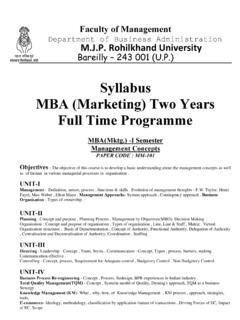Transcription of Learning objectives
1 Learning objectivesBy the time you have worked through this chapter, you will be able to: zExplain the difference between a story idea and a hypothesis zDraw up an investigative reporting plan zCreate and deliver an informative, convincing story pitch zExplain the uses and limitations of different types of source material and different investigation methods zUnderstand what a paper trail is and how to begin tracking one zDraw up and use criteria of authenticity and adequacy for evidence and zDraft useable timelines and budgets. If you are confident that you already have these skills, go straight to zChapter 4 for a detailed look at finding and using sources zChapter 5 for more on interviewing zChapter 6 for technical guidance on computer-assisted and number-based ( financial) research zChapter 7 for advice on analysing your evidence, packaging it, and writing the the investigation3-2 Planning the investigationWhy plan?
2 The previous chapter looked at sources of good story ideas. We saw that while tips from informed insiders are immensely useful to investigative reporters, they are not the only source of ideas, and that all sources have their own characteristics and also saw that the best story ideas are not necessarily the biggest: the best story ideas are those that go to the heart of a real problem in the community or broader society where reporters you cannot just move from idea straight to investigation. What you have is just a starting point. Because investigative stories carry a heavy social responsibility and various legal risks you must be sure your reporting is as thorough, accurate and comprehensive as possible.
3 Because media work is a team effort, you also need to ensure that there s good communication with colleagues. And because investigative reporting needs resources, you need to make certain these will be in place. For all these reasons, you need to plan the work that will go into your your idea came from will be one of the factors shaping your work plan. If the idea came from your own observations, or from anecdotal evidence, you need to be sure that these individual experiences really represent a broader trend or issue. If the idea came from a tip, you must check the authenticity, reliability and possible motives of the source even before you move forward.
4 We noted these questions in Chapter 2 and you ll find more on source-checking in the next even if the sources are impeccable and the initial facts irrefutable, there is a first stage you have to go through: turning your story idea into a tightly-focused hypothesis or question that the investigation will prove, disprove or answer. You need to do this because: It makes the work manageable by giving it boundaries and goals It assists in communicating and selling the idea to others It allows you to budget time and resources more accurately It provides criteria of relevance for the evidence you collect It lays the foundation for a coherent final , a plan is never set in stone.
5 As you ll see from what follows, it has to have sufficient flexibility to cope with the new information and new directions your investigation will group of African investigative reporters working across several countries came together and discovered their communities had very similar problems. All were suffering resource exploitation and depletion, spearheaded by big multinational companies. All could pinpoint corrupt officials whose corruption was damaging service delivery and the rule of law. All saw and in some cases personally experienced the devastation of diseases such as HIV/Aids, malaria, pneumonia and the problems caused by lack of medicines to treat these.
6 They decided that there was scope here for transnational investigations where the experience of several countries brought together could comprehensively explore the this would be a massive and complex undertaking. Every aspect, from selecting the topic to carving up the work would need to be tightly controlled, in order to make sure the final project came together properly. The organisation was the Forum for African Investigative Reporters (FAIR) and the resulting transnational investigation, on the availability of medicines, forms the case study for this chapter, on page 3-19.
7 First, we look at the ingredients that go into planning any investigative reporting project, large or the investigationVery often, you ll find you have the story idea in broad general terms that will allow you to investigate a wide (and probably unmanageable) universe of topics. A good technique for developing and refining this idea is to write your way into it. Try to compose a story summary: a paragraph that describes what the final story will look like. This is a way of opening newsroom minds to the story, and sketching out a range of possible explanations.
8 It also helps you to see whether the story can be treated as local, or whether it might have national, regional or even pan-African implications. For example:A lot has been written about the impact of water privatisation on poor people in Africa. X municipality in our country privatised its water services three years ago, and our paper s local office has been receiving many complaints that water is now unaffordable and repair services are unreliable. Now there has been a big outbreak of diarrhoea in the area. Some people are saying the water supply is no longer poor; others are saying that people who cannot afford private water are using other unsafe sources.
9 This story will look at the impact of water privatisation on the community and whether our water is still , national or regional?This big picture approach is a good basis for further brainstorming. It takes you some way towards focusing the story, but not all the way. It s quite abstract and general almost academic rather than journalistic. It doesn t define its terms, and raises issues that could take the story in different directions or split it into different themes. zIs our focus safety or cost? These could be two stories. zDoes impact mean impact only on the poor?
10 Are there problems in middle-class communities too? What about industrial and agricultural water users in the area? zDo we want to see if the same problems exist in other regions? In other countries around us? Internationally?(These questions, of course, may form the basis of other, future stories. Don t throw away the results of such brainstorming.)There are some other, more detailed frameworks that can help you tighten this very general level of description and see exactly what your IJ project should be. The first is the classic formula for focusing a story: What s been happening?
